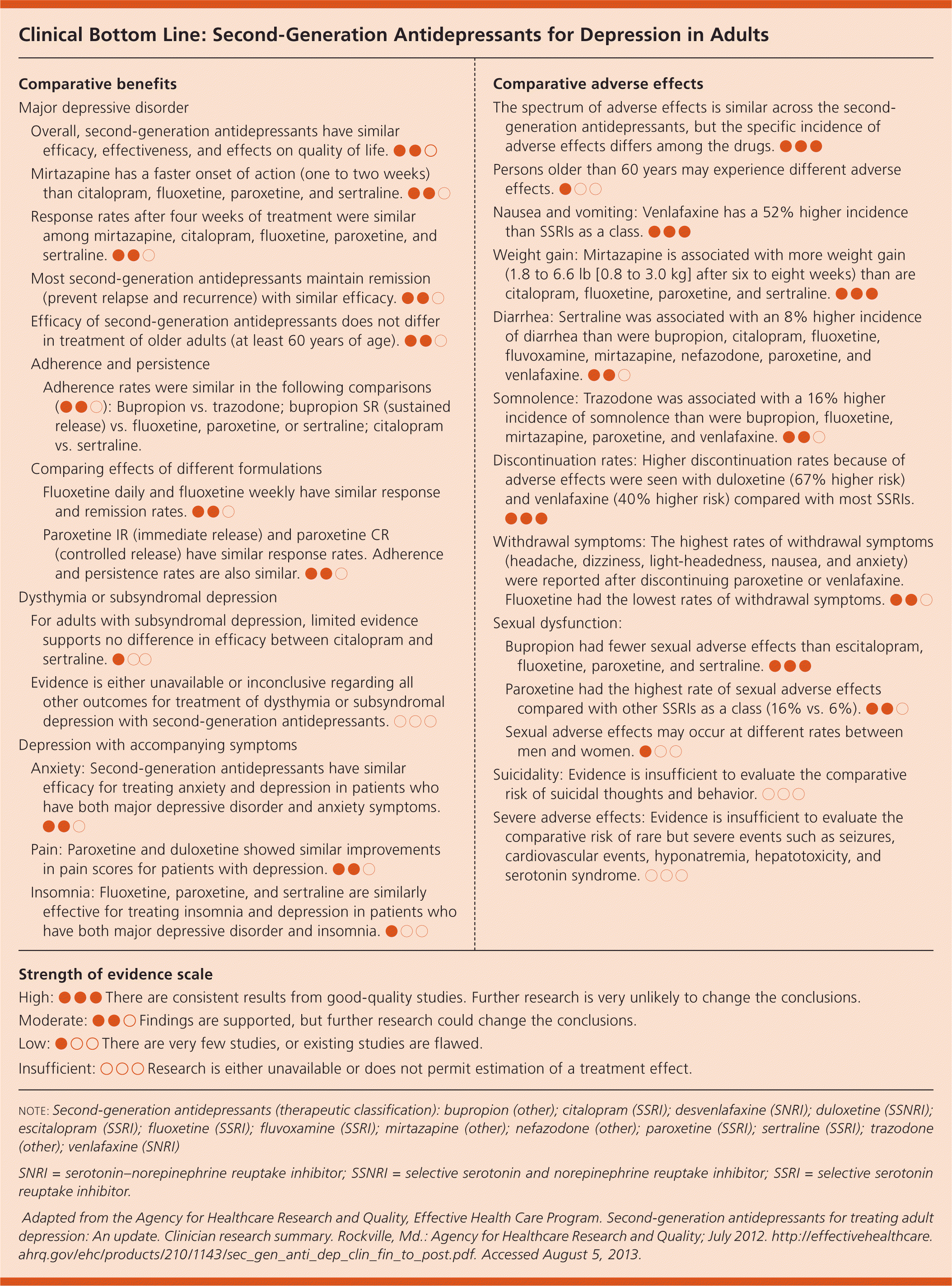
Am Fam Physician. 2013;88(10):687-689
See the the full review, clinician summary, consumer summary, and CME activity.
Author disclosure: No relevant financial affiliations.
Key Clinical Issue
What are the comparative effectiveness and adverse effects of second-generation antidepressants for treating depression in adults?
Evidence-Based Answer
Second-generation antidepressants (antidepressants other than tricyclics and monoamine oxidase inhibitors) used to treat major depressive disorder in adults have similar effectiveness. However, some clinically significant differences among individual drugs exist with respect to onset of action and adverse effects, which may affect treatment choices. For example, mirtazapine has a faster onset of action, but is associated with greater weight gain. Also, bupropion has fewer sexual adverse effects than many comparators. More research is needed to evaluate whether the benefits or adverse effects of second-generation antidepressants differ in subgroups or in populations with accompanying symptoms such as anxiety, insomnia, or chronic pain. (Strength of Recommendation: A, based on consistent, good-quality patient-oriented evidence.)

| Comparative benefits | |
Major depressive disorder
| |
Dysthymia or subsyndromal depression
| |
Depression with accompanying symptoms
| |
| Comparative adverse effects | |
| |
| Strength of evidence scale | |
| High: ●●● There are consistent results from good-quality studies. Further research is very unlikely to change the conclusions. | |
| Moderate: ●●○ Findings are supported, but further research could change the conclusions. | |
| Low: ●○○ There are very few studies, or existing studies are flawed. | |
| Insufficient: ○○○ Research is either unavailable or does not permit estimation of a treatment effect. |
Practice Pointers
All second-generation antidepressants, have similar effectiveness for treatment of major depressive disorder, with a 60% overall response rate.1 Therefore, it is reasonable to make the initial choice of a second-generation antidepressant for depression based on known adverse effect profiles, as recommended in current guidelines from the American Psychiatric Association2 and the American College of Physicians.3 For example, paroxetine (Paxil) is associated with more sexual adverse effects, and mirtazapine (Remeron) with more weight gain. Trazodone causes increased somnolence, and may be a good choice in patients with difficulty sleeping. Formulation (e.g., daily vs. weekly dosing, immediate vs. controlled release) does not impact clinical effectiveness.1
For patients with resistant depression, a large randomized trial showed no difference in response rates among sustained-release bupropion (Wellbutrin SR), sertraline (Zoloft), and extended-release venlafaxine (Effexor XR).4 Some lower-quality studies suggest venlafaxine may be slightly superior to fluoxetine (Prozac), mirtazapine, paroxetine, sertraline, and citalopram (Celexa).5 No studies have compared second-generation antidepressants for relapsed depression.
Evidence from 31 studies in the AHRQ review suggests that most second-generation antidepressants are effective for preventing relapse. No particular second-generation antidepressant is superior at maintaining remission based on existing head-to-head studies.1 No evidence currently exists to help guide patients in switching from one second-generation antidepressant to another.
Evidence from seven fair-quality head-to-head trials in the AHRQ review suggests that antidepressants do not differ substantially in effectiveness for patients with major depressive disorder and comorbid anxiety symptoms. Five trials included in the AHRQ review showed no substantial differences in effectiveness among second-generation antidepressants for treatment of major depressive disorder with accompanying insomnia.1
Overall, second-generation antidepressants have similar adverse effects; these occur in 63% of patients and include constipation, diarrhea, dizziness, headache, insomnia, nausea, sexual dysfunction, and somnolence. Nausea and vomiting are the most common reasons for discontinuation.6 Venlafaxine has a higher incidence of nausea than the selective serotonin reuptake inhibitors.
A good systematic review indicates that paroxetine and venlafaxine have the highest rates of antidepressant discontinuation syndrome, whereas fluoxetine has the lowest.7 More information on antidepressant discontinuation syndrome can be found at https://www.aafp.org/afp/2006/0801/p449.html. There is insufficient evidence on the comparative risks of second-generation antidepressants on the most serious adverse effects: suicidality, hyponatremia, cardiovascular events, seizures, hepatotoxicity, and serotonin syndrome.
